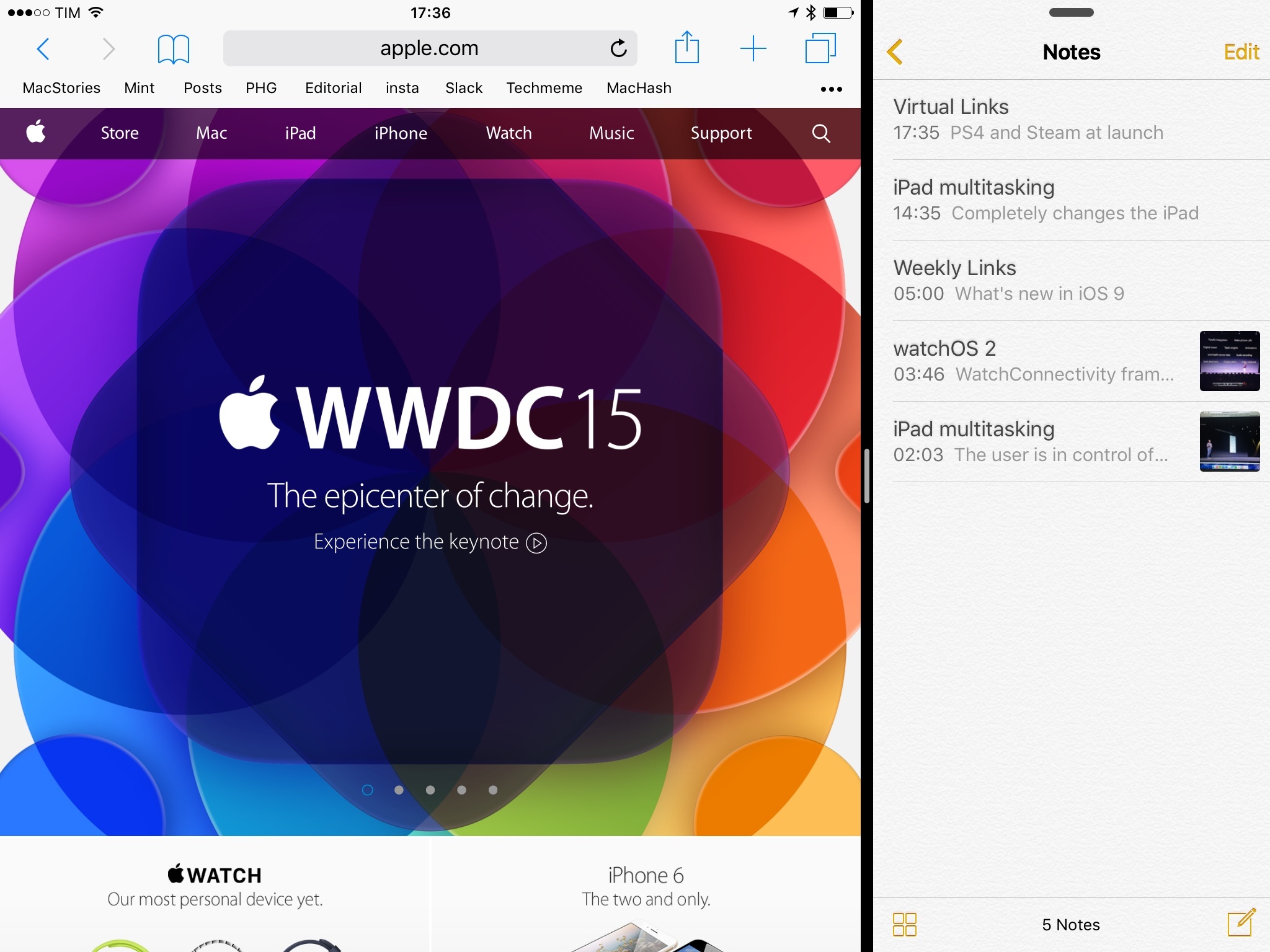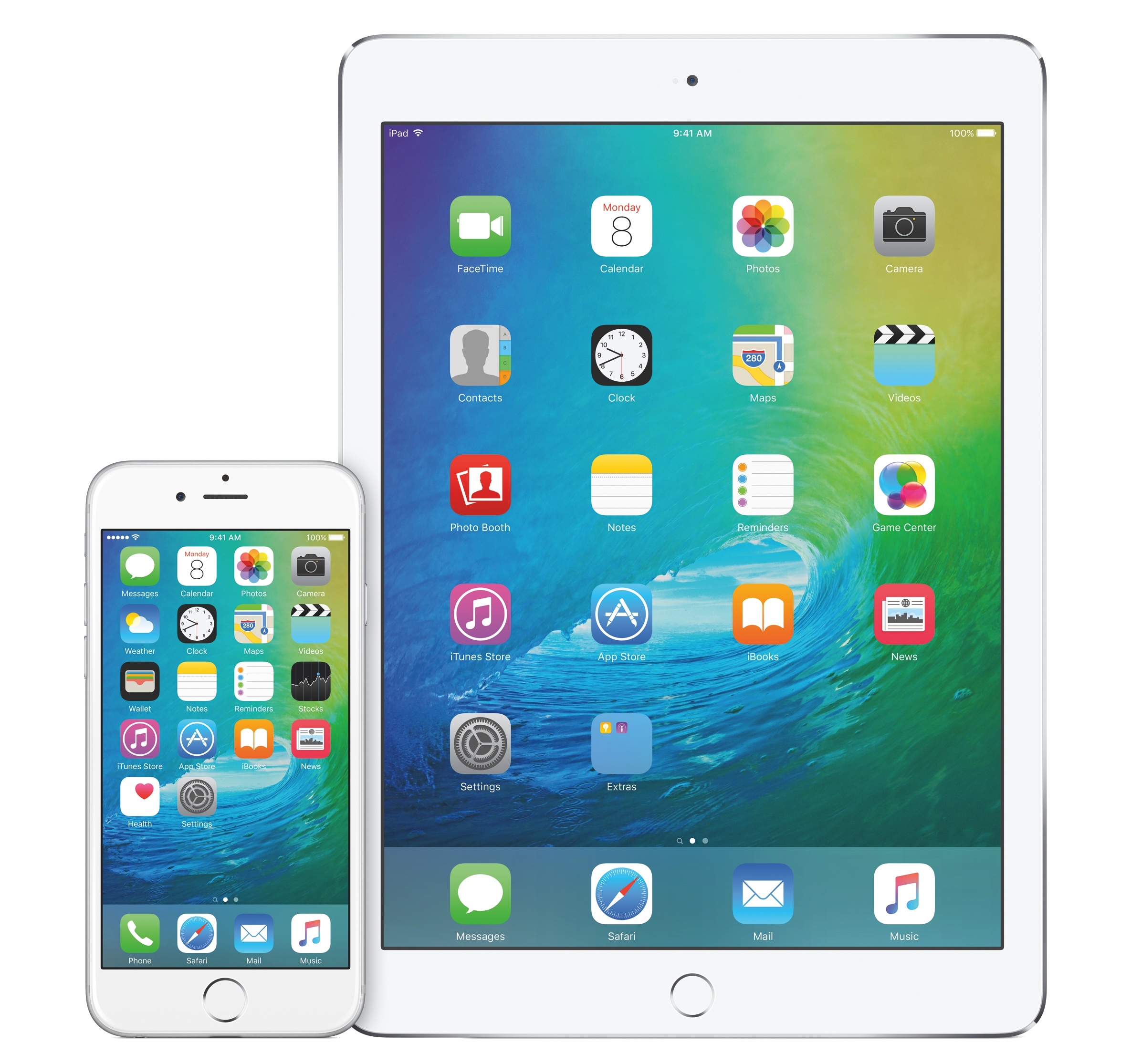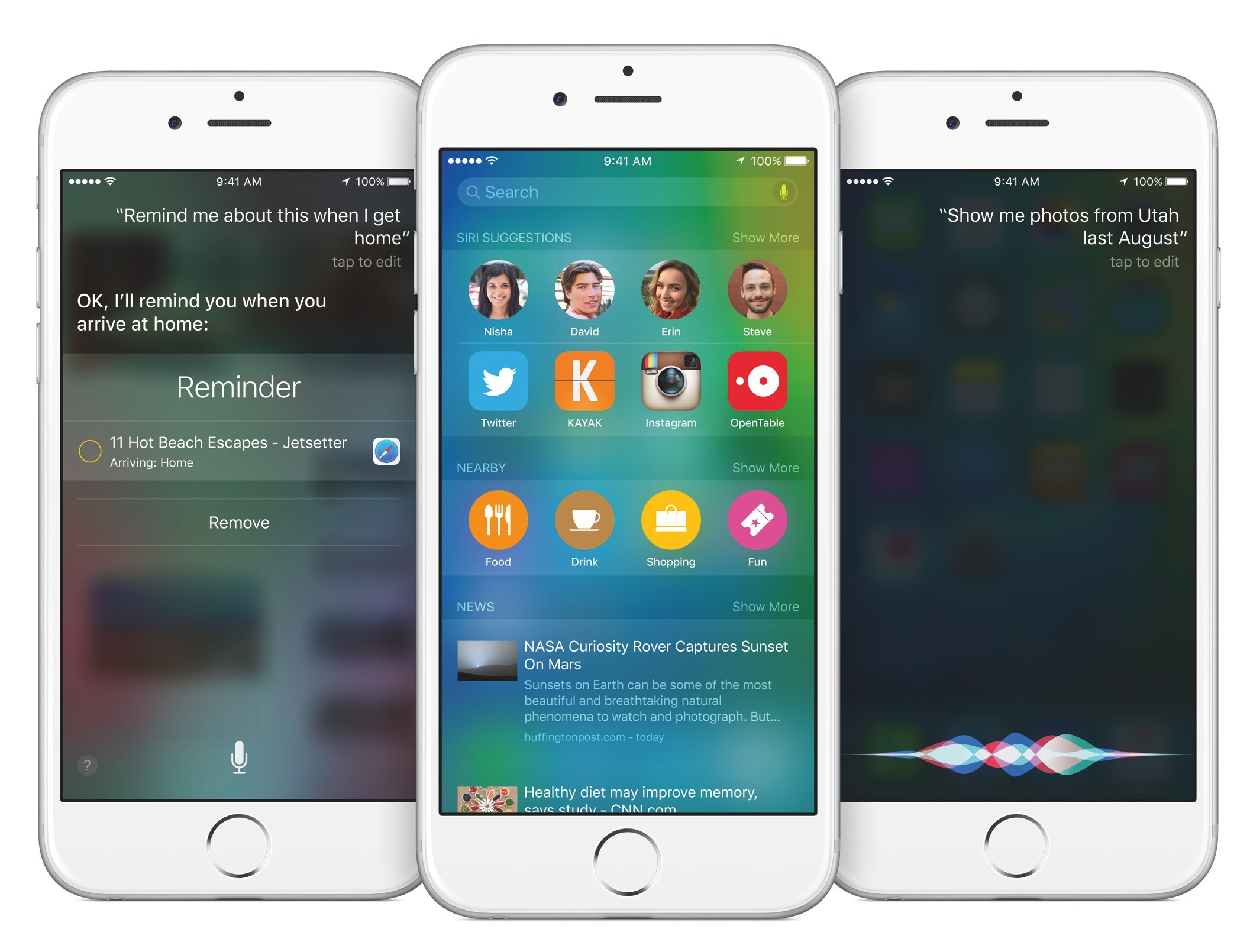The iPad is my primary computer. What Apple announced at WWDC this week completely changes the iPad and, I believe, will mark a turning point for the device.
Posts tagged with "iOS 9"
Initial Thoughts on iOS 9’s iPad Multitasking: A Deep Transformation
App Thinning and iOS 9→
Apple already talked in the keynote about how it had reduced the amount of space required the iOS 9 OTA update from around 4.6GB to 1.3GB, but a more transformative technology only got a passing mention: App Thinning. In short, apps in iOS 9 will leave your phone or tablet with more free space in the first place.
Say you have an iPhone 5C, which uses a 32-bit CPU and a GPU that doesn’t support the Metal API. Download a modern universal game, and that binary includes 64-bit code, iPad and “3x” iPhone 6 Plus assets, and Metal API code that it doesn’t need. It only needs the 32-bit code, “2x” iPhone-sized assets, and the OpenGL graphics code. App Slices will let your device download just the chunks your device needs.
Andrew Cunningham has a good overview of the developer features powering App Thinning, Apple’s effort to reduce app sizes in iOS 9.
I forgot that I had a similar idea in 2012, when Apple was rumored to introduce a Retina iPad that would increase app sizes going forward (as it did). I wrote:
I see two solutions. Either Apple gets the carriers to agree to larger download sizes, establishing a new “average” that should work for most apps (let’s say 60 MB as Panzarino suggests), or they rebuild the download mechanism completely by allowing devices to “ignore” resources they don’t need. The second solution would be a “cleaner” approach, in that it would address the root of this likely scenario – that is, devices downloading apps containing all kinds of images and resources for Retina and non-Retina displays.
By “localizing” images in a way languages are localized on the OS, Apple could find a way to know if an image is destined to an iPad or not. And if so, if it’s also destined to a Retina iPad, or old-generation iPad. Furthermore, in theory, this would also allow Apple to differentiate between images used by an iPhone and iPad which, right now, are always downloaded within the same, single .app package.
App Thinning – and the three core features behind it – sound promising, but we’ll have to assess their effects in practice and wait to see how many developers start supporting them. Apple doesn’t seem to be willing to discontinue lower capacity iOS devices, but at least they’re trying to save space in other ways.
iOS 9 Search and Universal Links→
iOS 9 puts a big focus on getting into apps faster and returning to where you left off quickly. As I wrote last night:
To achieve such new level of contextual interactions between Siri and apps, Apple is relying on deep linking, a feature that’s been available on other OSes or through third-party frameworks and that will be enabled by default on iOS 9. Deep linking refers to the ability to return to a specific area of an app at any given time. In Siri’s case, a deep link will let you return from Reminders to a message, but the technology will also power other areas of iOS to allow users to easily get back to where they left off in an app. For example, deep linking will be used to index content within apps for search. To make the process of moving between apps faster, Apple has built a new back button that will be displayed in the top left of the screen to return to the previous app with one tap.
Besides blurring the line between app and OS, seamless transitions between the web and apps will also be a fundamental theme of iOS 9. The implications are profound – especially for Google.
Apple is taking a dual approach with deep linking: they’re making it easy for users to navigate across apps (not to just launch them) and they’re building new technologies to expose app content locally and link webpages to apps.
Apple calls deep links to native apps Universal Links, and they work by specifying the path to sections of an app with a JSON file on a website.
In iOS 9, your app can register to open web links (using https or http) directly, bypassing Safari. This connection between your app and website helps Apple surface your app content in search results.
Universal Links fall under the bigger initiative of Search in iOS 9, which encompasses the web, Siri, local apps, and even apps that aren’t installed on a device.
App Search in iOS 9 gives users great new ways to access information inside of your app, even when it isn’t installed. When you adopt iOS 9 Search, users can access activities and content deep within your app through Handoff, Siri Reminders, and Search results.
As Apple elaborates:
For an example of how this works, imagine that your app helps users handle minor medical conditions, such as a sunburn or a sprained ankle. When you adopt iOS 9 Search, users searching their devices for “sprained ankle” can get results for your app even when they don’t have your app installed. When users tap on a result for your app, they get the opportunity to download your app.
If this sounds similar to what Google announced in April, it’s because the underlying idea is very similar.
Upon skimming through iOS 9’s documentation, my first impression is that Apple wants to further cut out Google from search on iOS not by removing traditional web searches, but by building a superior user experience. In theory, looking for content from an integrated search box and having results seamlessly transition to native apps or prompt to install new apps seems better than asking users to go to google.com. The new back button, Universal Links, and app/web indexing technologies are aimed at finding information quickly, navigating between apps easily, and connecting webpages to apps directly.
It remains to be seen if Apple’s solution will be widely adopted and if it’ll actually be better than Google search. I have many thoughts, but I’ll save them for the future.
WWDC 2015: Interesting Tidbits and Links
Every year at WWDC, Apple unveils dozens of new software features and hundreds of developer technologies, and 2015 was no exception. With new versions of iOS, OS X, and a big 2.0 update to watchOS weeks after its public debut, Apple is preparing for a busy Fall across its ecosystems.
Among big additions and redesigns, however, there are always smaller features and hidden changes that the company only briefly mentioned during the keynote or described with a short paragraph on their preview webpages and developer documentation guides. In this article, we’ve collected some of the most interesting details we didn’t cover yesterday, with links to the original articles, documentation, and tweets.
For more in-depth coverage, check out our overviews and first impressions:
iOS 9: Our Complete Overview and First Impressions
Apple announced iOS 9, the next major version of its mobile operating system, at WWDC 2015 this week, with a focus on iPad productivity, enhancements to built-in apps, better intelligence, and improvements to performance and security.
Part an iterative update aimed at refining missteps and missing features of iOS 8 and part a new beginning for Siri and iPad users, iOS 9 isn’t the “Snow Leopard release” that some tech pundits were asking for. iOS 9 is building upon the foundation of iOS 8 with dozens of new features – many of which could profoundly impact the way we interact with our apps and devices every day.
iOS 9 Wishes
I concluded last year’s assessment of iOS 8 on a positive note:
The scope of iOS 8’s changes will truly make sense as developers keep building brand new experiences over the coming months. iOS has begun to open up, and there’s no stopping at this point.
For some Apple observers, it’d be easy – and justifiable – to argue that Apple is “done” with improving iOS given the software’s maturity and sprawling app ecosystem. With long-awaited technologies such as action extensions, widgets, custom keyboards, folders for iCloud, and external document providers finding their way to iPhones and iPads, iOS has seemingly reached a zenith of functionality, an ideal state with no low-hanging fruit left to lust for.
Except that iOS 8 wasn’t a culmination aimed at ending on a high note. As I wrote last September, the changes introduced with iOS 8 laid the foundation for a more flexible, customizable, and ultimately more powerful mobile OS that would pave the road for the next several years of iOS updates.
There’s always going to be new low-hanging fruit in iOS. And 2015 is no exception.
iOS 8 changed how I work on my iPhone and iPad. For years, I had been entertaining the idea of going all-in with iOS, but I was never able to take the leap. I couldn’t manage to leave my MacBook behind and let my workflow rely on iOS apps. My lifestyle dictates being able to write, communicate with others, and manage MacStories from anywhere, free from the constraints of a MacBook. Thanks to iOS 8 and the improved hardware of the iPad Air 2, I chose the iPad as my primary computer – and instead of being cautiously concerned about the trade-offs of iOS, I just felt relieved.
The iPad, for me, is a product of intangibles. How its portable nature blurs the line between desktop computers and mobile. How a vibrant developer community strives to craft apps that make us do better work and record memories and enjoy moments and be productive and entertained. The iPad, for me, is a screen that connects me with people and helps me with my life’s work anywhere I am. Transformative and empowering, with the iPad Air 2 being its best incarnation to date. Not for everyone, still improvable, but absolutely necessary for me. And, I believe, for others.
Liberating. The iPad is a computer that lets me work and communicate at my own pace, no matter where I am.
Beyond the conceptual implications of using a portable 10-inch screen as a computer every day1, extensions and widgets had the strongest practical effect on me. The ability to push select pieces of information to widgets and the objectification of apps through extensions have allowed me to augment the apps I use with functionalities taken from other apps. I can automate Safari with the Workflow extension; I can copy multiple bits of text in a row and trust that a clipboard manager will hold them all for me. For someone who works on iOS, version 8.0 was a massive change with far-reaching potential for the future.
As with every year, I’ve been pondering where I’d like to see iOS go next. Software is never done, but iOS 8 made a compelling argument for the maturity of the platform – if anything, from a feature checklist perspective. That’s not how I look at it, though: I suspect that the next major version of iOS – likely to be called iOS 9 – will use the visual and technical foundation of iOS 7 and iOS 8 to unlock new levels of integration and communication between apps, iCloud, gestures, and voice input.2
While it’s possible that Apple will bring some of the design expertise and taste acquired when finalizing the Watch UI back to iOS, that won’t be the focus of this article. Instead, like every year since 2012, I’ll elaborate on the software additions and corrections I would like to see on iOS, from the perspective of someone who works from an iPad and even came to appreciate the iPhone 6 Plus.
For context, you can check out my old wishes for iOS 6, iOS 7, and iOS 8 to reflect on my motivations and what Apple ended up announcing at past WWDCs.





